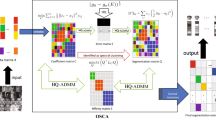Abstract
In recent years, graph based subspace clustering has attracted considerable attentions in computer vision, as its capability of clustering data efficiently. However, the graph weights built by using representation coefficients are not the exact ones as the traditional definition. That is, the two steps are conducted in independent manner such that an overall optimal result cannot be guaranteed. To this end, in this paper, a novel subspace clustering via learning an adaptive graph affinity matrix is proposed, where the soft label and the representation coefficients of data are learned in an unified framework. First, the proposed method learns a robust representation for the data through least square regression, which reveals the subspace structure within data and captures various noises inside. Second, the segmentation is sought by conducting spectral clustering simultaneously. Most importantly, during the optimization process, the segmentation is utilized to iteratively enhance the block-diagonal structure of the learned representation to further assist the clustering process. Experimental results on several famous databases demonstrate that the proposed method performs better against the state-of-the-art approaches, in clustering.



Similar content being viewed by others
Notes
c is the number of cluster.
The entropy \(\text {H}(K)\) is defined as \(\text {H}(K)= \sum \nolimits _{y \in {K}}{- p(y)\cdot \log _2(p(y))}\) where p(y) is the probability that a sample belongs to a cluster.
References
Chung FRK (1997) Spectral graph theory. American Mathematical Society, Providence
Costeira J, Paulo O, Kanade T (1998) A multibody factorization method for independently moving objects. Int J Comput Vis 29(3):159–179
Elhamifar E, Vidal R (2013) Sparse subspace clustering: algorithm, theory, and applications. IEEE Trans Pattern Anal Mach Intell 35(11):2765–2781
Fang X, Xu Y, Li X, Lai Z, KeungWong W (2015) Learning a nonnegative sparse graph for linear regression. IEEE Trans Image Process 24(9):2760–2771
Guo X (2015) Robust subspace segmentation by simultaneously learning data representations and their affinity matrix. In: Proceedings of IJCAI, pp 3547–3553
Lai Z, Xu Y, Chen Q, Yang J, Zhang D (2014) Multilinear sparse principal component analysis. IEEE Trans Neural Netw Learn Syst 25(10):1942–1950
Li K, Yang J, Jiang J (2014) Nonrigid structure from motion via sparse representation. IEEE Trans Cybern 45(8):1401–1413
Lin Z, Liu R, Li H (2015) Linearized alternating direction method with parallel splitting and adaptive penalty for separable convex programs in machine learning. Mach Learn 99(2):287–325
Liu G, Lin Z, Yu Y (2010) Robust subspace segmentation by low-rank representation. In Proceedings of the 27th international conference on machine learning (ICML-10), pp 663–670
Lu CY, Min H, Zhao ZQ, Zhu L, Huang DS, Yan S (2012) Robust and efficient subspace segmentation via least squares regression. In: European conference on computer vision, pp 347–360
Von Luxburg U (2007) A tutorial on spectral clustering. Stat Comput 17(4):395–416
Ma Y, Derksen H, Hong W, Wright J (2007) Segmentation of multivariate mixed data via lossy data coding and compression. IEEE Trans Pattern Anal Mach Intell 29(9):1546–1562
Nie F, Wang X, Huang H (2014) Clustering and projected clustering with adaptive neighbors. In: Proceedings of the 20th ACM SIGKDD international conference on knowledge discovery and data mining, pp 977–986
Parsons L, Haque E, Liu H (2004) Subspace clustering for high dimensional data: a review. SIGKDD Explor Newsl 6(1):90–105
Peng X, Yi Z, Tang H (2015) Robust subspace clustering via thresholding ridge regression. In: Proceedings of AAAI, AAAI’15, pp 3827–3833
Rockafellar RT (1970) Convex analysis. Princeton University Press, Princeton
Shen LL, Bai L, Ji Z (2011) FPCODE: an efficient approach for multi-modal biometrics. Int J Pattern Recognit Artif Intell 25(2):273–286
Tipping M, Bishop C (1999) Mixtures of probabilistic principal component analyzers. Neural Comput 11(2):443–482
Tseng P (2000) Nearest q-flat to m points. J Optim Theory Appl 105(1):249–252
Vidal R, Tron R, Hartley R (2008) Multiframe motion segmentation with missing data using powerfactorization and GPCA. Int J Comput Vis 79(1):85–105
Yang AY, Wright J, Ma Y, Sastry SS (2008) Unsupervised segmentation of natural images via lossy data compression. Comput Vis Image Underst 110(2):212–225
Yin M, Gao J, Lin Z (2016) Laplacian regularized low-rank representation and its applications. IEEE Trans Pattern Anal Mach Intell 38(3):504–517
Yin M, Gao J, Lin Z, Shi Q, Guo Y (2015) Dual graph regularized latent low-rank representation for subspace clustering. IEEE Trans Image Process 24(12):4918–4933
Zhang J, Han Y, Jiang J (2015) Tensor rank selection for multimedia analysis. J Vis Commun Image Represent 30:376–392
Zhang T, Szlam A, Lerman G (2009) Median k-flats for hybrid linear modeling with many outliers. In: 2009 IEEE 12th international conference on computer vision workshops (ICCV workshops). IEEE, pp 234–241
Zhu Z, Jia S, He S, Sun Y, Ji Z, Shen L (2015) Three-dimensional gabor feature extraction for hyperspectral imagery classification using a memetic framework. Inf Sci 298:274–287
Author information
Authors and Affiliations
Corresponding author
Additional information
This work was supported by the National Natural Science Foundation of China Grants (61473253, 11301427, 61773130), in part by the Fundamental Research Funds for the Central Universities under No. XDJK2014B021. Ming Yin’s work was supported in part by the Guangdong Natural Science Foundation under Grant (No. 2014A030313511), in part by the Scientific Research Foundation for the Returned Overseas Chinese Scholars, State Education Ministry, China, in part by Science and Technology Planning Project of Guangdong Province (No. 2017A010101024), China, in part by Science and Technology Program of Guangzhou, China (No. 201604016086).
Rights and permissions
About this article
Cite this article
Wu, Z., Yin, M., Zhou, Y. et al. Robust Spectral Subspace Clustering Based on Least Square Regression. Neural Process Lett 48, 1359–1372 (2018). https://doi.org/10.1007/s11063-017-9726-z
Published:
Issue Date:
DOI: https://doi.org/10.1007/s11063-017-9726-z




